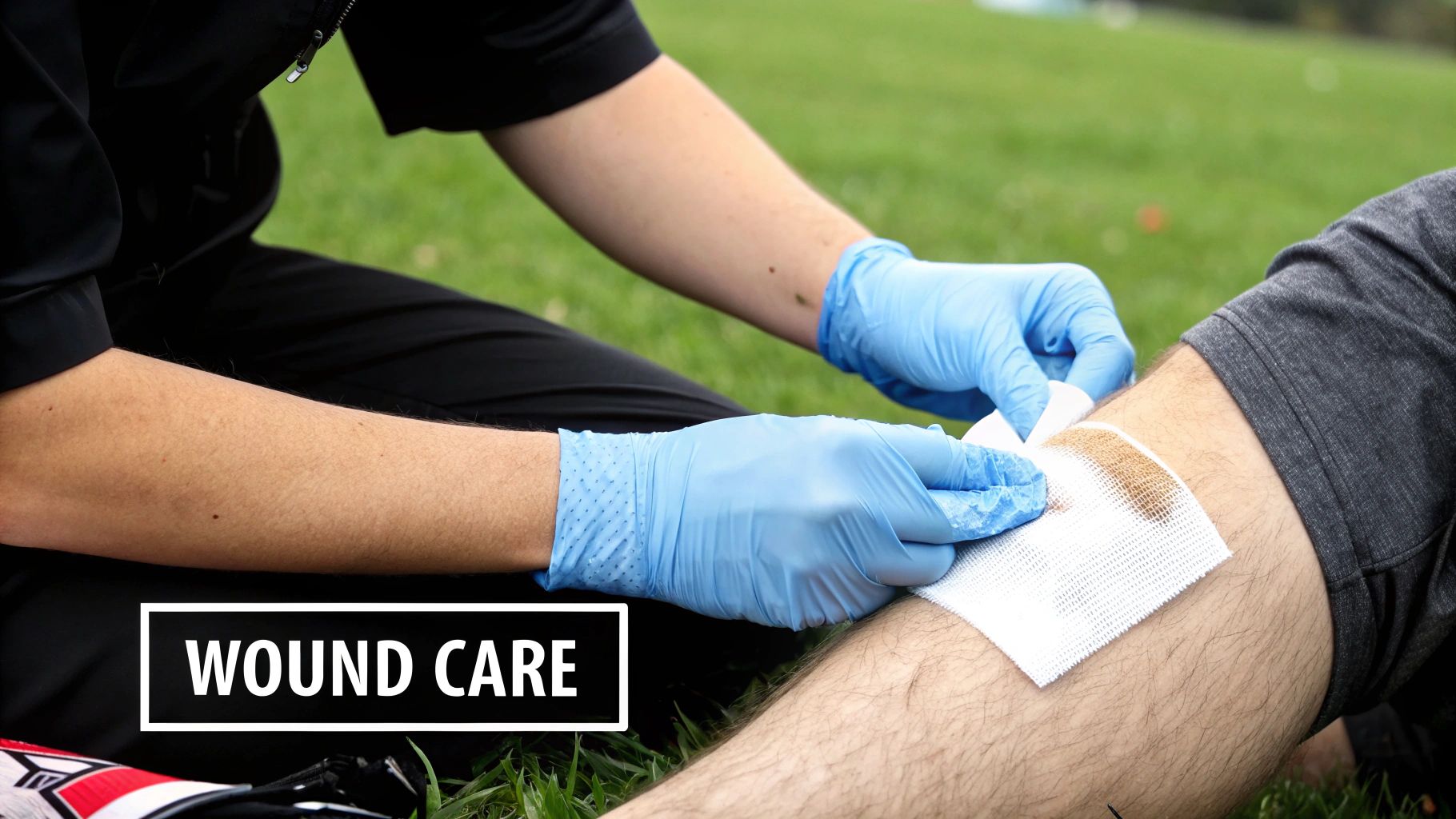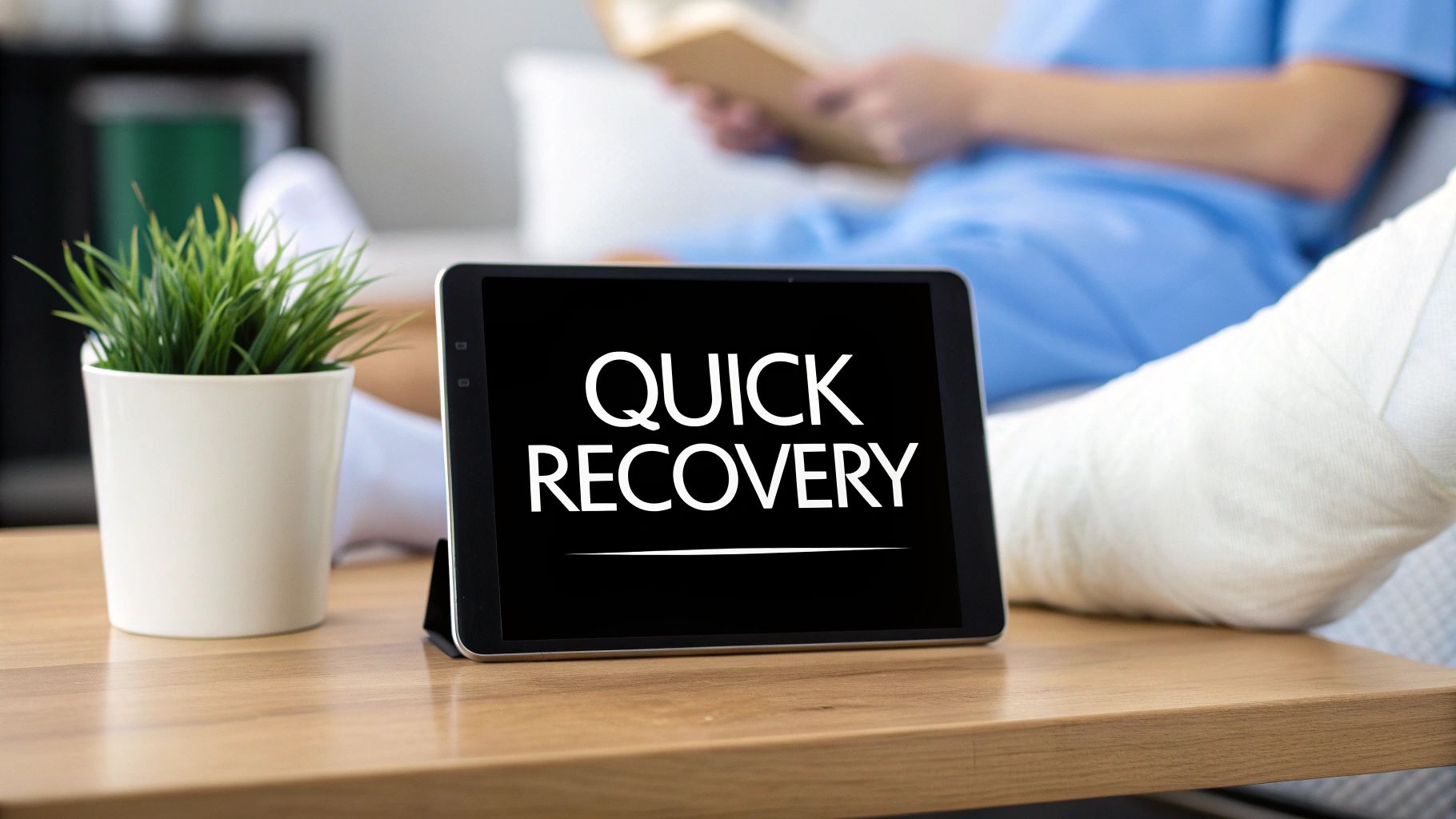Effective leg ulcer treatment at home begins with understanding the specific nature of your ulcer. This involves identifying the type of ulcer and its underlying cause. This knowledge helps guide your home care approach and ensures you’re using the right strategies.
Different Types of Leg Ulcers
Several types of leg ulcers exist, each with distinct characteristics. Knowing these differences is crucial for effective treatment.
- Venous Leg Ulcers: These ulcers often appear around the ankles. They result from poor blood circulation in the veins, leading to increased pressure. This causes fluid leakage into surrounding tissue, impairing healing.
- Arterial Leg Ulcers: Resulting from Peripheral Artery Disease (PAD), these ulcers develop due to narrowed arteries. This restricts blood flow to the legs and feet. The resulting lack of oxygen and nutrients hinders healing, often leading to painful ulcers on the toes or feet.
- Diabetic Ulcers: People with diabetes are prone to these ulcers due to a combination of poor circulation and nerve damage (neuropathy). Even small injuries can become ulcers due to impaired healing and reduced sensation, often leading to unnoticed wounds worsening.
Identifying the ulcer type is crucial. For example, compression therapy, vital for venous leg ulcers, can harm arterial ulcers. When considering home versus clinical care, explore cost options like affordable health insurance for seniors.
Exploring the Root Causes
Understanding the root causes is as important as identifying the ulcer type. Venous leg ulcers are primarily caused by chronic venous insufficiency, where veins struggle to return blood to the heart. Addressing this underlying condition is essential for effective treatment.
Factors like obesity, smoking, and immobility contribute significantly to leg ulcer development. Obesity increases leg pressure, worsening venous insufficiency. Smoking damages blood vessels and hinders circulation. Immobility reduces blood flow and increases ulcer risk, especially for those bedridden or with limited mobility.
The prevalence of venous leg ulcers (VLUs) varies globally. In Westernized countries, VLUs affect approximately 1% of the general population and about 3% of people over 80. VLUs often require prolonged care, with 50% taking over a year to heal, and 20% potentially not healing even after two years. This emphasizes the importance of consistent home care. Learn more about venous leg ulcers. Accurate diagnosis and addressing the root cause are vital for successful at-home treatment.
Building Your Leg Ulcer Home Care Toolkit

Successfully managing leg ulcer treatment at home requires the right supplies. Think of it as assembling a toolkit for a home improvement project. Having the correct tools on hand makes the entire process smoother and more effective. This guide will help you build a practical and efficient home care toolkit for treating leg ulcers.
Essential Supplies: Your Foundation For Healing
The core of your toolkit includes supplies for cleansing the wound, applying dressings, and improving circulation. These are the essential elements for successful at-home treatment.
- Cleansing Solutions: Use a saline solution or a mild, non-cytotoxic cleanser. Avoid harsh antiseptic solutions, as these can damage healthy tissue and slow down the healing process.
- Dressing Materials: The appropriate dressing depends on the specific characteristics of your ulcer. Absorbent dressings are best for wounds that drain heavily. Hydrocolloid dressings help maintain a moist wound environment. Alginate dressings are suitable for wounds with excessive exudate.
- Compression Bandages or Stockings: Compression therapy is vital for venous leg ulcers, as it encourages blood flow back to the heart. Your doctor will advise you on the correct compression level.
Organizing Your Toolkit: Efficiency and Hygiene
A well-organized toolkit is essential for efficient and hygienic treatment. Just like a well-maintained toolbox, an organized system makes the process easier and minimizes the risk of infection.
- Designated Storage Space: Keep your supplies in a clean, dry place, away from direct sunlight and moisture. A clear plastic container or a dedicated drawer works well.
- Inventory System: Regularly check your supplies and replenish them as needed. This ensures you always have the necessary items available and avoids treatment delays.
- Hygiene Practices: Always wash your hands thoroughly before and after changing your dressing. Wearing disposable gloves provides an extra layer of protection against infection.
The following table provides a comprehensive list of essential leg ulcer home care supplies:
Essential Leg Ulcer Home Care Supplies
| Supply Category | Specific Items | Purpose | Replacement Frequency |
|---|---|---|---|
| Cleansing Solutions | Saline solution, non-cytotoxic cleanser | Cleanse the wound bed | As needed during each dressing change |
| Dressing Materials | Absorbent dressings, hydrocolloid dressings, alginate dressings | Protect the wound, absorb drainage, promote healing | As directed by physician or wound care specialist, typically daily or every other day |
| Compression Therapy | Compression bandages, compression stockings | Improve blood flow, reduce swelling | Bandages: Daily or as directed. Stockings: As per manufacturer instructions, usually daily |
| Other Supplies | Disposable gloves, non-stick pads, scissors, tape | Maintain hygiene, secure dressings | Gloves: Each dressing change. Other items: As needed |
This table summarizes the key supplies you’ll need for effective home care, their purpose, and how often they typically need replacing. Always consult your doctor for personalized recommendations.
Cost-Effective Solutions and Alternatives
Managing leg ulcers can be costly, but budget-friendly options are available. Finding these alternatives can make long-term care more manageable.
- Bulk Purchasing: Buying frequently used items like gauze or saline solution in bulk can lead to significant savings.
- Reusable Compression Garments: While some compression bandages are disposable, compression stockings are reusable, offering a more economical choice for long-term compression therapy.
- Improvised Organization Solutions: You can repurpose household items like shoeboxes or drawer dividers to organize your supplies, avoiding the need for specialized organizers.
Creating a well-stocked and organized home care toolkit empowers you to actively participate in your treatment journey. This proactive approach not only promotes healing but also gives you a greater sense of control over managing your condition. Remember to consult your healthcare provider or a wound care specialist like those at the Association for the Advancement of Wound Care for personalized advice and a treatment plan tailored to your specific needs.
Mastering Wound Cleansing and Dressing Techniques

Successfully treating leg ulcers at home depends heavily on proper wound cleansing and dressing techniques. These practices are essential for preventing infection and fostering a healing environment. This guide offers practical advice on mastering these crucial skills.
Cleansing the Wound: A Gentle Approach
Wound cleansing is the first step in changing dressings. It removes debris and bacteria, creating a clean wound bed for optimal healing. However, gentleness is key. Scrubbing too hard can damage new tissue and slow down the healing process.
- Choosing the Right Solution: Normal saline solution is generally the best choice for cleansing most leg ulcers. It’s gentle, easy to find, and won’t interfere with the delicate healing process. Avoid harsh antiseptics, which can harm healthy tissue.
- The Cleansing Process: Gently rinse the wound with saline solution using a syringe or a squeeze bottle. Avoid cotton balls or swabs, as the fibers can stick to the wound. Gently pat the area dry with a clean, non-stick pad.
Dressing the Wound: Choosing and Applying
After cleansing, the next step is applying the right dressing. The best type of dressing depends on the ulcer’s characteristics, including the amount of drainage and the healing stage.
- Dressing Selection: For ulcers with a lot of drainage, absorbent dressings like alginates or foam dressings are helpful. For wounds with less drainage, hydrocolloid dressings can maintain a moist environment and encourage healing. Your healthcare provider will recommend the most suitable dressing for your individual needs.
- Application Technique: Apply the dressing gently, making sure it covers the entire wound bed without extending onto the healthy skin around it. Secure the dressing with tape or a bandage. Avoid putting on too much pressure, as this could restrict blood flow. This keeps the dressing in place and allows for good airflow.
Common Mistakes to Avoid
Even with the right supplies and good intentions, it’s easy to make mistakes. Understanding these common errors can prevent setbacks in your healing journey. For example, using adhesive tape directly on fragile skin can cause more damage. Instead, use non-stick pads under the tape to protect the surrounding skin.
Another frequent mistake is changing dressings too often. While regular dressing changes are important, changing them too frequently can disrupt the healing process. Follow your healthcare provider’s instructions regarding how often to change your dressings.
Practical Tips for Patients
Managing leg ulcer treatment at home can be challenging. However, some simple strategies can make the process much easier. If you have limited mobility or dexterity, consider using assistive devices like long-handled applicators or dressing aids.
Also, setting a regular routine for dressing changes can improve consistency. Choose a specific time each day and set up a comfortable, dedicated space for the procedure. This helps you stick to your treatment plan and makes the process less of a disruption. Consult with Rapid Wound Care or other wound care providers about any challenges you face for personalized guidance to enhance your at-home leg ulcer treatment. They can provide helpful resources and insights to effectively navigate the practical aspects of home care.
Compression Therapy: Transform Your Healing Journey

Compression therapy plays a vital role in treating leg ulcers at home, particularly venous leg ulcers. These ulcers often stem from poor blood circulation. Compression therapy applies external pressure to help blood return to the heart, minimizing swelling and encouraging healing.
The Science Behind Gradient Compression
Compression therapy uses gradient pressure. This means the highest pressure is at the ankle, gradually decreasing as it moves up the leg. This replicates the natural muscle pump in your legs, helping veins carry blood back to the heart.
This improved circulation brings much-needed oxygen and nutrients to the ulcer, speeding up the healing process. It also reduces edema (swelling), a frequent complication of venous insufficiency that can slow down tissue repair.
Choosing the Right Compression System for You
Several compression systems are designed for home use, each with its pros and cons. Knowing these differences helps you select the most suitable option based on your lifestyle, mobility, and ulcer characteristics.
- Compression Bandages: These offer adaptable pressure and can be tailored to different leg shapes. However, they can be tricky to apply correctly without help.
- Compression Stockings: These stockings are easy to put on and provide consistent compression. They come in various pressure classes, ranging from mild to high compression.
- Compression Pumps: These devices use air-filled sleeves or boots that inflate and deflate intermittently, stimulating blood flow. They tend to be pricier than bandages or stockings but deliver dynamic compression.
To help you understand the differences, the table below compares these compression methods.
The following table provides a comparison of different compression therapy options suitable for home application, including their advantages, disadvantages, and appropriate usage scenarios.
Comparison of Home Compression Options
| Compression Type | Pressure Level | Ease of Application | Cost | Best For | Limitations |
|---|---|---|---|---|---|
| Bandages | Adjustable | Can be difficult | Relatively low | Irregularly shaped legs, varying swelling | Requires proper application technique |
| Stockings | Predetermined | Easy | Moderate | Mild to moderate venous insufficiency | May not be suitable for severe swelling |
| Pumps | Intermittent | Easy | High | Severe venous insufficiency, lymphedema | Can be bulky, requires electricity |
This table highlights the key differences between the three main types of at-home compression therapy. Bandages offer adjustable pressure but can be difficult to apply, while stockings are easier to use but have pre-determined pressure levels. Compression pumps provide intermittent pressure and are suitable for more severe conditions, but come at a higher cost.
Applying and Maintaining Compression Therapy
For compression therapy to be effective, consistent and correct application is key. Learn how to apply your chosen system, handle common problems, and integrate this therapy into your daily routine.
- Application Techniques: Ensure bandages or stockings are smooth and wrinkle-free to prevent pressure sores. Follow the manufacturer’s instructions carefully.
- Troubleshooting: Address issues like slipping or discomfort by adjusting application methods or trying different product sizes. Consult your healthcare provider if problems continue.
- Adapting to Lifestyle: Adjust your compression strategy based on weather changes or activity levels. In hotter weather, lighter compression or shorter wear times might be more comfortable.
Venous leg ulcers significantly impact quality of life and healthcare costs. In the United States, around 600,000 new lower leg ulcer cases occur each year, with 80% attributed to venous return issues. Research indicates that optimal care with high-compression therapy decreases the annual hospitalization probability to 1.16%, compared to 4.8% with standard care. Explore this topic further. Consistent compression therapy is crucial for successful at-home leg ulcer treatment. By understanding compression principles, selecting the appropriate system, and mastering application techniques, you can significantly improve your healing process and regain your quality of life. Consult your healthcare provider for any questions about compression therapy and its potential benefits for your situation.
Healing From Within: Nutrition That Speeds Recovery
Proper nutrition plays a vital role in treating leg ulcers at home. The foods you consume directly affect your body’s capacity to mend damaged tissue and combat infection. This makes nutritional support a critical element of your treatment strategy.
The Diet-Wound Healing Connection
Imagine your body as a construction zone, with the leg ulcer representing the area needing repair. Proper nutrition delivers the essential building materials – proteins, vitamins, and minerals – required for effective reconstruction. Without these crucial nutrients, the healing process slows considerably.
Protein, for instance, is indispensable for generating new skin cells and mending damaged tissue. Vitamin C is essential for creating collagen, the protein that gives skin its structure and strength. Zinc bolsters immune function, assisting your body in fighting infections that can impede ulcer healing.
Key Nutrients For Faster Healing
Certain nutrients are especially important for leg ulcer recovery. Including these in your diet can dramatically improve healing times.
- Protein: Focus on lean protein sources like fish, poultry, beans, and lentils. These provide the amino acids needed for tissue repair.
- Vitamin A: Present in foods such as sweet potatoes, carrots, and spinach, Vitamin A promotes cell growth and immune function.
- Vitamin C: Citrus fruits, berries, and bell peppers are excellent sources of Vitamin C, vital for collagen production.
- Zinc: Increase your zinc intake with foods like oysters, nuts, and seeds. This mineral contributes to immune function and wound healing.
- Iron: Found in red meat, leafy greens, and fortified cereals, iron plays a key role in oxygen transport, essential for tissue repair.
Meal Planning and Practical Tips
Putting nutritional science into practice can seem daunting. However, simple methods can make healthy eating more manageable, even with limited cooking skills or a restricted budget.
- Focus on whole foods: Prioritize fruits, vegetables, lean proteins, and whole grains. These are filled with essential nutrients.
- Meal prepping: Prepare meals or meal components ahead of time to save time and ensure you have healthy choices readily available.
- Budget-friendly choices: Beans, lentils, and frozen fruits and vegetables offer both nutrition and affordability.
- Simple recipes: Seek out recipes that require minimal ingredients and cooking time, concentrating on nutrient-rich foods.
Meeting your nutritional needs is fundamental for successful leg ulcer treatment at home. By understanding the link between diet and wound healing and incorporating key nutrients into your meals, you can actively support your body’s natural healing processes. For personalized advice, consult a registered dietitian or your healthcare provider. They can assist you in developing a meal plan tailored to your specific requirements and health conditions. Services like those offered by Rapid Wound Care can also provide valuable resources and assistance for managing your leg ulcer at home, including nutritional guidance.
Breaking the Pain Cycle in Leg Ulcer Recovery
Pain management is crucial for treating leg ulcers at home. Uncontrolled pain can make simple tasks, like dressing changes, incredibly difficult. This section explores effective at-home pain management strategies for leg ulcers, promoting consistent treatment and a better quality of life.
Understanding Leg Ulcer Pain
Leg ulcer pain varies based on the ulcer type and individual factors. Venous ulcers often cause a dull ache, while arterial ulcers can produce a sharp, burning sensation, especially at night. Infections introduce a throbbing pain. Understanding these different pain types is crucial for effective treatment.
It’s also important to distinguish between pain from healing and pain from a complication. Mild tenderness during dressing changes can be normal, but a sudden pain increase could indicate an infection. Always communicate significant pain changes to your healthcare provider.
Pain Management Strategies at Home
Effective pain relief involves a combination of approaches. Finding the right balance for your needs is key to successful home treatment.
- Medication: Over-the-counter pain relievers like ibuprofen or acetaminophen can manage mild to moderate pain. Your doctor may prescribe stronger medication for severe pain.
- Topical Treatments: Certain creams and ointments can provide localized pain relief. Always consult your doctor before applying any topical treatment to your ulcer.
- Compression Therapy: For venous leg ulcers, compression improves blood flow, reducing swelling and associated aching pain.
- Elevating Your Legs: Elevating your legs above your heart reduces swelling and pressure, minimizing pain.
Beyond Medication: Non-Pharmaceutical Approaches
Effective pain management goes beyond medication. These additional strategies can significantly improve your comfort and well-being.
- Distraction Techniques: Engaging in enjoyable activities like reading, listening to music, or spending time with loved ones can distract from pain.
- Relaxation Exercises: Techniques like deep breathing or meditation can reduce stress and anxiety often associated with chronic pain.
- Dietary Changes: Diet is vital for leg ulcer recovery. Consider adding anti-inflammatory foods to your diet.
The Mind-Body Connection: Managing Anxiety and Pain
Chronic pain and anxiety are often linked. Anxiety can amplify pain, while chronic pain can worsen anxiety. Addressing this mind-body connection is vital for effective pain management.
Cognitive Behavioral Therapy (CBT) techniques can help break negative thought patterns that intensify pain. These techniques empower you to challenge unhelpful thoughts, lessening their impact on your physical sensations. Relaxation techniques like mindfulness or guided imagery can also promote calm, reducing both anxiety and pain. Integrating these strategies into your home treatment plan can significantly improve your overall quality of life.
Remember, effectively managing leg ulcer pain at home is a journey involving both physical and psychological approaches. It requires patience, consistency, and open communication with your healthcare provider.
Home Care or Clinical Care: Making Informed Decisions
Deciding where to treat your leg ulcer—at home or in a clinic—is a crucial step in your healing journey. This decision depends on several factors, including the type and severity of your ulcer, your personal resources, and the support systems available to you. This section provides a balanced perspective to help you make the best choice for your situation.
Factors Influencing Your Decision
Several key factors influence whether home care or clinical care is the best approach for your leg ulcer. These considerations help create a personalized plan that addresses your specific needs and circumstances.
- Wound Characteristics: A small, superficial venous ulcer might be manageable at home with proper guidance. However, a deep, infected ulcer or an arterial ulcer might require the specialized care of a clinical setting.
- Personal Capabilities: Home care demands consistent effort and attention to detail. If you have limited mobility or find it difficult to adhere to a daily care regimen, clinical care might be a more suitable option.
- Support Systems: Do you have family members or caregivers who can assist with dressing changes or other aspects of home care? Strong support can make at-home treatment more feasible.
The Benefits and Limitations of Each Approach
Both home care and clinical care offer specific advantages and disadvantages. Understanding these trade-offs helps make an informed decision.
- Home Care: Home care offers comfort and convenience, allowing you to manage your treatment in a familiar environment. This can also be less expensive than frequent clinic visits. However, it requires significant self-discipline and access to appropriate resources.
- Clinical Care: Clinics provide access to advanced treatments, specialized wound care expertise, and regular monitoring of your progress. This is especially beneficial for complex or slow-healing ulcers. However, clinic visits can be time-consuming and may involve travel expenses.
The effectiveness of both approaches has been studied. Evidence suggests that home care can be as effective as clinic-based care for many patients, if they receive proper support and guidance. For instance, one study showed that appropriate support at home can lead to outcomes comparable to clinical settings. However, successful home care relies heavily on following self-care advice and using evidence-based treatments, particularly compression therapy. Learn more about evidence-informed leg ulcer care. Despite these potential challenges, home care remains an important option due to its convenience and potential cost savings.
Maximizing Collaboration With Healthcare Providers
Whether you choose home care or clinical care, close collaboration with your healthcare team is essential. Open communication and shared decision-making enhance your treatment plan and ensure optimal outcomes.
- Regular Check-Ups: Schedule regular appointments with your doctor or wound care specialist, even if you’re managing your ulcer at home. This allows them to monitor your progress, adjust your treatment plan as needed, and identify potential complications early.
- Clear Communication: Be open about any challenges you’re facing, whether it’s pain management, dressing changes, or adherence to your treatment plan. Your healthcare provider can offer solutions and provide support.
- Tracking Progress: Take photos of your ulcer regularly and keep a journal documenting your pain levels, drainage, and any other relevant observations. This information helps your healthcare team assess your healing progress and make informed decisions about your care.
Making the Right Choice For You
The decision between home care and clinical care is personal. Consider your specific circumstances, weigh the benefits and limitations of each approach, and prioritize open communication with your healthcare team. By working together, you can develop a treatment plan that maximizes your healing potential and improves your overall quality of life. For expert guidance and comprehensive wound care services, contact Rapid Wound Care today. Their team of certified professionals is dedicated to providing personalized treatment plans and support, ensuring you receive the best possible care for your leg ulcer, whether at home or in a clinical setting.

